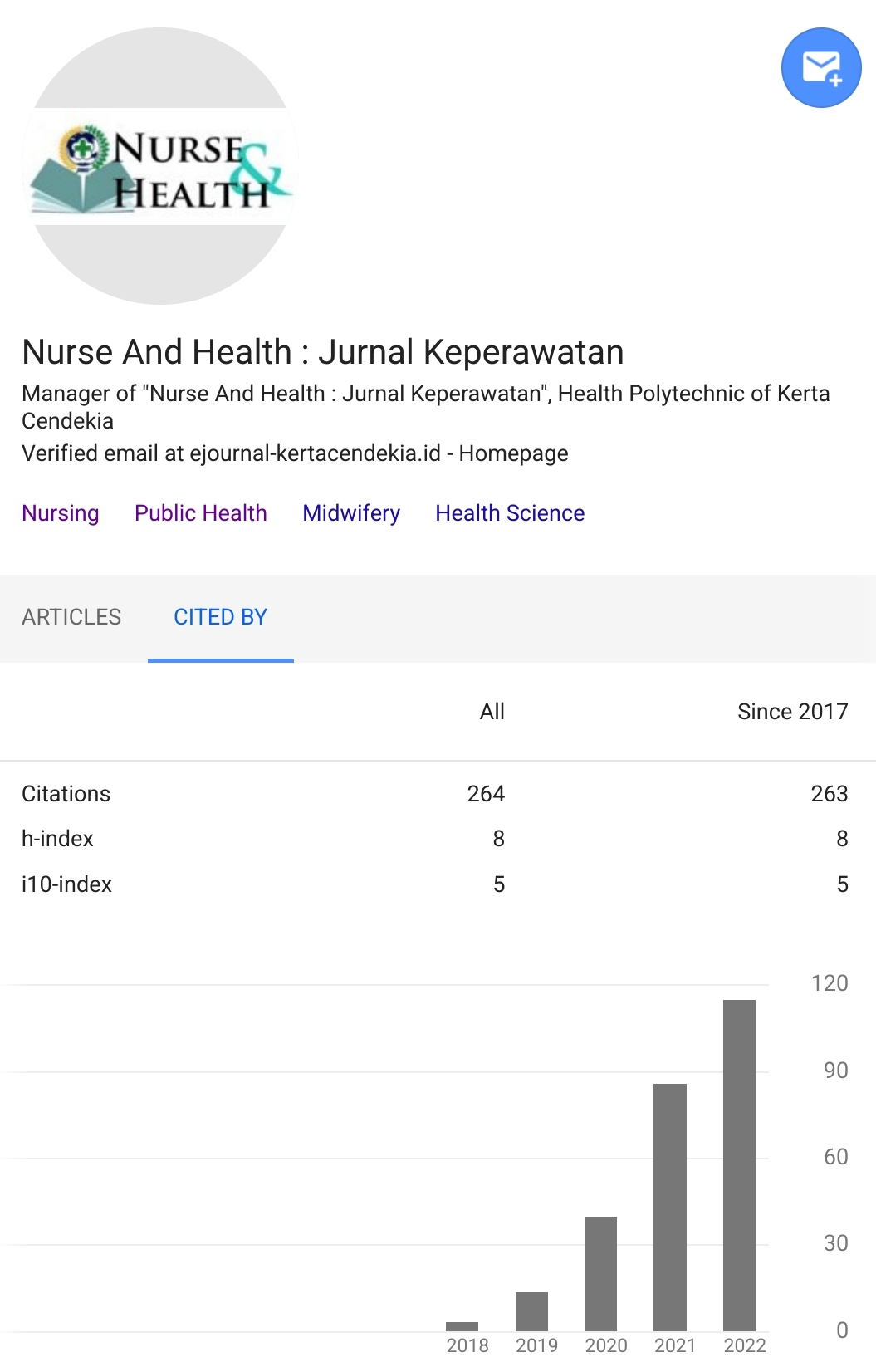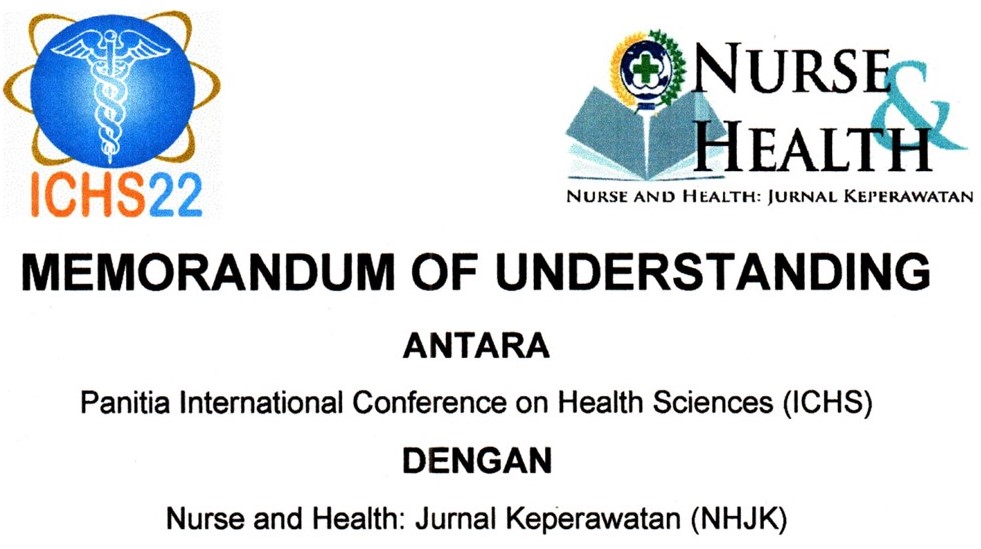EFFECTIVENESS OF STANDARDIZED PATIENTS AND ROLE-PLAY SIMULATION METHODS IN IMPROVING SELF-CONFIDENCE AND THERAPEUTIC COMMUNICATION SKILLS OF NURSING STUDENTS
Abstract
Background: Communication skills are critical skills that must be possessed by nurses because communication is a dynamic process that is used to collect assessment data, provide education or health information to influence clients to apply it in life, show caring, provide comfort, foster self-confidence and, value respect - client value. Nurses in communicating with clients must have high confidence in the effect of these communications.Objectives: The purpose of this study was to analyze the differences in the effect of standardized patient simulation methods and role play in increasing self-confidence and therapeutic communication skills of students of the Nursing Academy of Pasuruan.Methods: The design of this study is the quasi experimental study. There are two therapeutic communication training groups. Group A uses a Standardized Patient (SP) and, Group B uses the role play (RP) method. The population in this study were students of the Nursing Academy of Pasuruan, and the sample was taken by simple random sampling with a sample size group of 16 standardized patients and a roleplay group of 16 people. The measuring instrument used was an observation sheet on therapeutic communication skills and a questionnaire on confidence in therapeutic communication. The effectiveness of the two methods was analyzed by the non-parametric test, namely the Mann Whitney test, to test 2 unpaired samples.Results: The results of this study indicate that there are differences in standardized patient methods and role play on self-confidence and therapeutic communication skills in nursing academy students who are statistically significant at 0.03 (p=0.05).Conclusion: The standardized patient method is more effective in increasing self-confidence and therapeutic communication skills in nursing academy students compared to the roleplay method. Keywords: Standardized Patient, Roleplay, Therapeutic Communication, Self-ConfidenceDownloads
References
Aebersold, M., Tschannen, D., & Bathish, M. (2012). Innovative Simulation Strategies in Education. Nursing Research and Practice, 2012. DOI: http://dx.doi.org/10.1155/2012/765212.
Baumann, M., Baumann, C., Le Bihan, E., & Chau, N. (2008). How patients perceive the therapeutic communications skills of their general practitioners, and how that perception affects adherence: use of the TCom-skill GP scale in a specific geographical area. BMC health services research, 8(1), 244.
Blatner, A. (2009). Role-Playing In Education. Retrived from http://www.blatner.com/adam/pdntbk/rlplayedu.htm
Blum, C. A., Borglund, S., & Parcells, D. (2010). High-fidelity nursing simulation: Impact on student self-confidence and clinical competence. International Journal of Nursing Education Scholarship, 7(1) 1-16.
Bosse, H. M., Nickel, M., Huwendiek, S., Jünger, J., Schultz, J. H., & Nikendei, C. (2010). Peer role-play and standardised patients in communication training: a comparative study on the student perspective on acceptability, realism, and perceived effect. BMC Medical Education, 10(1), 27.
Bowles, N., Mackintosh, C., & Torn, A. (2001). Nurses’ communication skills: an evaluation of the impact of solution‐focused communication training. Journal of Advanced Nursing, 36(3), 347-354.
Deveugele, M., Derese, A., De Maesschalck, S., Willems, S., Van Driel, M., & De Maeseneer, J. (2005). Teaching communication skills to medical students, a challenge in the curriculum?. Patient education and counseling, 58(3), 265-270.
Fukui, S., Ogawa, K., Ohtsuka, M., & Fukui, N. (2008). A randomized study assessing the efficacy of communication skill training on patients' psychologic distress and coping: nurses' communication with patients just after being diagnosed with cancer. Cancer: Interdisciplinary International Journal of the American Cancer Society, 113(6), 1462-1470. DOI: http://dx.doi.org/10.1002/cncr.23710.
Hermawan, A. H. (2010). Persepsi Pasien Tentang Pelaksanaan Komunikasi Teraputik Perawat Dalam Asuhan Keperawatan Pada Pasien di Unit Gawat Darurat RS. Mardi Rahayu Kudus November 2009 (Doctoral dissertation, Universitas Diponegoro).
Hober, C. L. (2012). Student perceptions of the observer role play experiences in the implementation of a high-fidelity patient simulation in bachelor's degree nursing programs (Doctoral dissertation, University of Kansas).
Joyce, B. R., & Weil, M. (2000). Role Playing; Studying Social Behavior and Values. Models of Teaching. Allyn and Bacon.
Jarvis, L., Odell, K., & Troiano, M. (2002). Role-playing as a teaching strategy. Strategies for application and presentation, staff development and presentation.
Lane, C., & Rollnick, S. (2007). The use of simulated patients and role-play in communication skills training: a review of the literature to August 2005. Patient education and counseling, 67(1-2), 13-20.
Lane, C., Hood, K., & Rollnick, S. (2008). Teaching motivational interviewing: using role play is as effective as using simulated patients. Medical Education, 42(6), 637-644.
Mullan, B. A., & Kothe, E. J. (2010). Evaluating a nursing communication skills training course: The relationships between self-rated ability, satisfaction, and actual performance. Nurse education in practice, 10(6), 374-378.
Mäkelä, E., Koistinen, S., Siukola, M., & Turunen, S. (2005). The process model of role playing. Dissecting LARP, 205-236.
Murti, B. (2006). Desain dan ukuran sampel untuk penelitian kuantitatif dan kualitatif di bidang kesehatan. Yogyakarta: Gadjah Mada University Press, 67, 113-3.
Notoatmodjo, S., (2010). Promosi Kesehatan Teori dan Aplikasi. Jakarta: Rineka Cipta.
Neven, R. S. (2010). Core principles of assessment and therapeutic communication with children, parents and families: Towards the promotion of child and family wellbeing. Routledge.
Potter, P.A. & Perry, A.G. (2010). Fundamental Keperawatan. Singapore: Elsevier.
Potter, P.A.,Perry, A.G., Stockert P., Hall A. (2014). Essentials for Nursing Practice. 8th Ed. St. Louis, Missouri: Mosby Elsevier.
Rauen, C. A. (2004). Simulation as a teaching strategy for nursing education and orientation in cardiac surgery. Critical care nurse, 24(3), 46-51.
Reading S, Webster B. (2013). Achieving Competencies for Nursing Practice: A Handbook for Student Nurses. England: Open University Press.
Sanford, P.G. (2010). Simulation in Nursing Education: A Review of the Research. The Qualitative Report, 15(4), 1006-1011.
Sleeper, J. A., & Thompson, C. (2008). The use of hi fidelity simulation to enhance nursing students' therapeutic communication skills. International Journal of Nursing Education Scholarship, 5(1), 1-12.
Suikkala, A., Leino-Kilpi, H., & Katajisto, J. (2008). Nursing student-patient relationships: a descriptive study of students' and patients' views. International Journal of Nursing Education Scholarship, 5(1), 1-12.
Supranto, J. (2000). Teknik Sampling untuk Survei dan Eksperimen. Jakarta: Rineka Cipta.
Suryani. (2014). Komunikasi Terapeutik Teori dan Praktek Edisi 2. Jakarta: EGC.
Stuart, G.W., Sundeen, S.J., (2013). Buku Saku Keperawatan Jiwa Edisi 5. Jakarta: EGC.
Üstün, B. (2006). Communication skills training as part of a problem-based learning curriculum. Journal of Nursing Education, 45(10).
Videbeck, S. L. (2008). Buku Ajar Keperawatan Jiwa. Jakarta: EGC.
Von Gunten, C. F., Ferris, F. D., & Emanuel, L. L. (2000). Ensuring competency in end-of-life care: communication and relational skills. Jama, 284(23), 3051-3057.
Waldner, M. H., & Olson, J. K. (2007). Taking the patient to the classroom: Applying theoretical frameworks to simulation in nursing education. International Journal of Nursing Education Scholarship, 4(1). DOI: http://dx.doi.org/10.2202/1548-923X.1317
Yedidia, M. J., Gillespie, C. C., Kachur, E., Schwartz, M. D., Ockene, J., Chepaitis, A. E., ... & Lipkin Jr, M. (2003). Effect of communications training on medical student performance. Jama, 290(9), 1157-1165.
Authors who publish with Nurse and Health: Jurnal Keperawatan agree to the following terms:
- Authors retain copyright licensed under a Creative Commons Attribution-NonCommercial 4.0 (CC BY-NC 4.0), which allows others to remix, tweak, and build upon the authors' work non-commercially, and although the others' new works must also acknowledge the authors and be non-commercial, they don't have to license their derivative works on the same terms.
- Authors are permitted and encouraged to post their work online (e.g., in institutional repositories or on their website) prior to and during the submission process, as it can lead to productive exchanges, as well as earlier and greater citation of published work (See The Effect of Open Access). Authors can archive pre-print and post-print or publisher's version/PDF.








_resize1.jpg)















